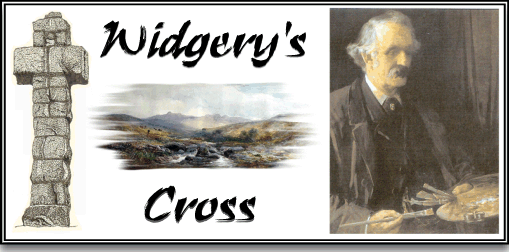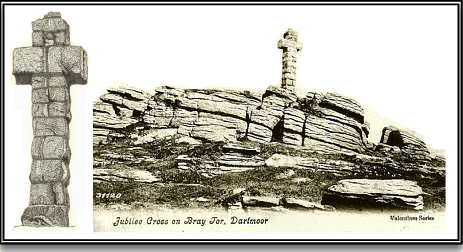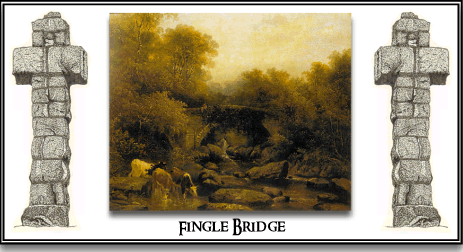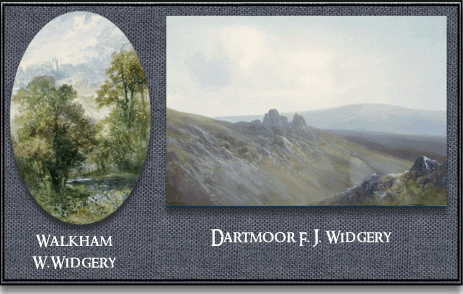
As you drive along the A386 between Okehampton and Tavistock you may notice a cross sited on a distant tor upon the skyline, this is ‘Widgery’s Cross’ or the ‘Jubilee Cross’. For 118 years the granite cross has stood looking over the western expanse of moor. The cross was erected by William Widgery to commemorate the Golden Jubilee of Queen Victoria in 1887. Widgery’s Cross holds three distinctions amongst the realms of Dartmoor crosses, firstly it is the only cross constructed of blocks of granite as opposed to being hewn from a single slab. Secondly it is the most visible of the crosses as it can be seen from many places on the moor. Thirdly the cross is the tallest of the all the Dartmoor granite crosses which stand outside of a cemetery. The cross stands on a tor commonly known as Brat tor, however, it has also been known as Brai, Widgery, Broad and Lur tor and stands at an altitude of 452 metres.
Widgery’s Cross is constructed from 10 courses of granite blocks and is capped with a rough slab. It has been suggested that the reason for this method of construction was to give the structure a greater stability which when one considers the exposure of the site would help the cross withstand the elemental forces imposed on it. The cross reaches a height of 12.99ft and has an arm span of 4.5ft, the words “W. Widgery, Fecit, Jubilee VR” are inscribed on the eastern side of the base stone. Widgery’s Cross is orientated on a east – west alignment which assists in its visibility from afar.

William Crossing indicates that the siting of the cross places it “in harmony with the wild surroundings,” further adding:
“this and its position, which is singularly striking, would suffice to show that the hand which set it up was guided by the eye of one who knew how to happily blend the work of art with that of nature.“, 1987, p117.
It is hardly surprising that the cross was sited by someone with an appreciation of the landscape as William Widgery was a noted dartmoor artist. He was born in North Molton in 1826 where as a young man he trained as a mason. Widgery then moved to Exeter where in his spare time he took to painting and was completely self-taught. He first learnt his painting skills by copying and selling some of Landseer’s and Bonheur’s work. An Exeter man called Thomas Hext spotted some of Widgery’s paintings which were hanging in a inn and soon persuaded the artist to give up his job and take up painting as a career. Many of his paintings were of the western tracts of Dartmoor which he soon became to love. It did not take him long to set up a studio and expand his travels to include the coasts of Devon and Cornwall, Switzerland and Venice. By 1883 it was estimated that he had painted over 3,000 pictures and sold everyone of them. As his fame grew it was said that his work was normally sold before it had left his easel. His work mainly consisted of landscapes using both oil and watercolour but occasionally he turned to portraits. It has been suggested that in his paintings he used more than a modicum of ‘poetic licence’, William Crossing recounts how a passer-by met Widgery painting on the moor and:
“… stopped to look over his shoulder at his work. He could not recognise the view before him as that which the artist was painting. In the foreground instead of a marsh there appeared a rocky stream. ‘Mr Widgery’, said the visitor mildly, ‘there is no river at the foot of that hill.’ ‘Isn’t there?’ returned the artist, without looking up; ‘well’ there ought to be.” , 1966, pp121-2.
In Crossing’s opinion, William Widgery along with John Syer were the “pioneers of Dartmoor painting,” 1966, p.121. It is said that because Widgery never had any formal art training he developed a style of his own which contributed greatly to his success. In 1881 George Pyecroft wrote of the artist:
“It is impossible to say that “Widgery is of the school of so-and-so,” although at the present time all the young painters are copying him. He has a style quite peculiar to himself, a style in which he catches effects, portrays rural scenes and wild landscapes boldly, and with very little finish… His pictures are well composed, and he has the power of selecting picturesque bits, and of arranging his subject in a bold easy manner, that appears utterly unstudied. He possesses the ‘ars celare artem’ (it is art to conceal art) to perfection his touch is remarkably light and free; his colour is entirely without crudity of heaviness; he never uses any blue but cobalt, and every variety of green and grey he makes with this, the lightest of colours. He mixes a little of the pigment with all his tints, and thus carries a softening atmospheric effect over the whole of the work.”
There was an article in The Times dated the 14th of April 1870 which relates how several of Widgery’s paintings were hung in the first class waiting room at Exeter’s St. David’s railway station. These depicted scenes from Chagford and the Teign and were painted in his “well-known and striking style.”
In 1880 Widgery built a house and studio on the edge of Lydford where he lived for 10 years. This building is now The Lydford House hotel and from which can clearly be seen Widgery’s Cross and who rather fittingly now offer painting holidays. In 1861 Widgery had a son called Frederick John who went through formal art training and in later years became another famed and prolific Dartmoor artist. William Widgery died in 1893.

One of Widgery’s patrons was an Exeter man called Kent Kingdon who purchased a number of his paintings and upon his death bequeathed them to the Royal Albert Memorial Museum in Exeter.
Today, William Widgery’s paintings command a high price when they come onto the market they easily fetch sums in thousands of pounds. Personally, whilst both father and son have produced excellent work I do favour the work of Frederick Widgery as all his moorscapes truly capture the spirit and light of Dartmoor. Below are examples of both William and Frederick Widgery’s work and to me there is a delicate subtlety to Fredrick’s picture but as with all art, it is a very personal thing.


Crossing, W. 1966 Dartmoor Worker, David & Charles, Newton Abbot.
Crossing, W. 1987 The Ancient Stone Crosses of Dartmoor, Devon Book, Exeter
Harrison, B. 2001 Dartmoor Stone Crosses, Devon Books & Halsgrove Pub, Tiverton.
Le Messurier, B. 2002 Dartmoor Artists, Halsgrove Publishing, Tiverton.
Sandles, T. 1997 Pilgrimage to Dartmoor’s Crosses, Forest Publishing, Liverton.
Starkey, F. 1983, Dartmoor Crosses, Starkey, Exeter.
 Legendary Dartmoor The many aspects past and present of Dartmoor
Legendary Dartmoor The many aspects past and present of Dartmoor

William Widgery’s grandson, Frederick Culley [1879-1942], became a film actor. He is best remembered for the role of the kindly Dr. Sutton in “The Four Feathers” [1939].
My favourite cross on Dartmoor. Lovely to read about its history. Thankyou!!